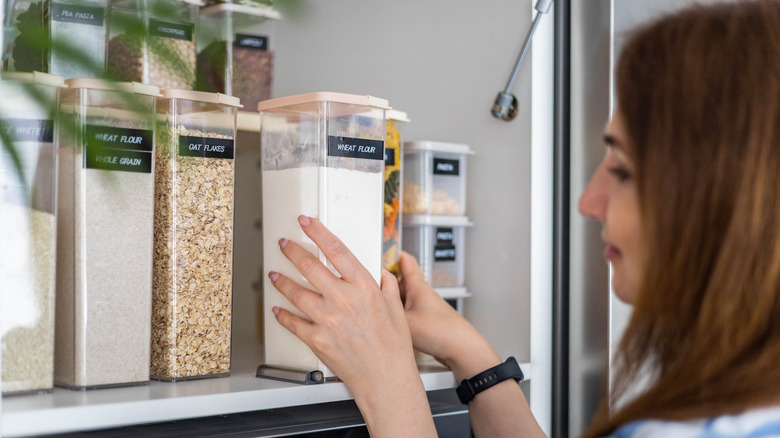Say Goodbye To Sticky Residue On Kitchen Storage Containers With This TikTok Find
We may receive a commission on purchases made from links.
Thanks to the likes of Marie Kondo and The Home Edit, people have embraced leveling up their kitchen storage to a new level. Gone are the days of haphazardly storing dry goods and cans in your pantry. Instead, people who value organization and tidiness take the time to decant them into plastic or glass containers and neatly line them up on shelves or in bins. Since the original packaging is tossed, it's also essential to label said containers in order to remind everyone in the household what the products inside are. But this creates a new, unique issue: If you want to change what you're storing in the container, you have to remove its label, which often leaves behind an annoying, sticky residue. However, TikTok users have been embracing dissolvable labels to remedy this problem.
Rather than using hacks like steam cleaners to remove sticky labels, you can make the process simpler and fuss-free by only using labels that dissolve once wet. That means you can completely remove the step of scraping off the sticker from your to-do list. Here's what you need to know about dissolvable labels.
Everything you need to know about dissolvable labels
These nifty labels do precisely as they promise. You stick them onto your container, label the jar's contents, and then simply wash them away under warm water when you're done. The sticker should take less than 30 seconds to dissolve completely, and there won't be any leftover residue that you have to scrape or scrub off. The label can stick to anything from plastic to glass to wood to metal, so it will adhere to any kind of pantry container. It's also very cost-effective. For example, the L-Liked brand on Amazon comes with 500 labels in a roll and costs $12. That means each label costs a mere two cents.
While each brand has its own formula on how to make these labels, most of them likely use plant material to achieve that dissolvable quality. For example, Mess Home's labels use cellulose made from wood pulp. Cellulose makes up plant cell walls, and this is paired with dissolvable paper to help it break down quickly when under water. Other environmentally friendly options include paper made from starch. Some might even use PVA film, also known as polyvinyl alcohol film. However, while this breaks down when in contact with moisture, it also releases microplastics down your sink, so it's not as environmentally friendly as other options.
